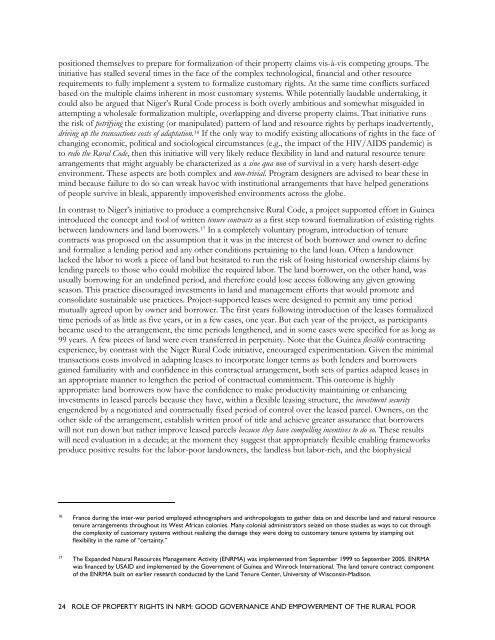the role of property rights in natural resource management, good ...
the role of property rights in natural resource management, good ...
the role of property rights in natural resource management, good ...
Create successful ePaper yourself
Turn your PDF publications into a flip-book with our unique Google optimized e-Paper software.
positioned <strong>the</strong>mselves to prepare for formalization <strong>of</strong> <strong>the</strong>ir <strong>property</strong> claims vis-à-vis compet<strong>in</strong>g groups. The<strong>in</strong>itiative has stalled several times <strong>in</strong> <strong>the</strong> face <strong>of</strong> <strong>the</strong> complex technological, f<strong>in</strong>ancial and o<strong>the</strong>r <strong>resource</strong>requirements to fully implement a system to formalize customary <strong>rights</strong>. At <strong>the</strong> same time conflicts surfacedbased on <strong>the</strong> multiple claims <strong>in</strong>herent <strong>in</strong> most customary systems. While potentially laudable undertak<strong>in</strong>g, itcould also be argued that Niger’s Rural Code process is both overly ambitious and somewhat misguided <strong>in</strong>attempt<strong>in</strong>g a wholesale formalization multiple, overlapp<strong>in</strong>g and diverse <strong>property</strong> claims. That <strong>in</strong>itiative runs<strong>the</strong> risk <strong>of</strong> petrify<strong>in</strong>g <strong>the</strong> exist<strong>in</strong>g (or manipulated) pattern <strong>of</strong> land and <strong>resource</strong> <strong>rights</strong> by perhaps <strong>in</strong>advertently,driv<strong>in</strong>g up <strong>the</strong> transactions costs <strong>of</strong> adaptation. 16 If <strong>the</strong> only way to modify exist<strong>in</strong>g allocations <strong>of</strong> <strong>rights</strong> <strong>in</strong> <strong>the</strong> face <strong>of</strong>chang<strong>in</strong>g economic, political and sociological circumstances (e.g., <strong>the</strong> impact <strong>of</strong> <strong>the</strong> HIV/AIDS pandemic) isto redo <strong>the</strong> Rural Code, <strong>the</strong>n this <strong>in</strong>itiative will very likely reduce flexibility <strong>in</strong> land and <strong>natural</strong> <strong>resource</strong> tenurearrangements that might arguably be characterized as a s<strong>in</strong>e qua non <strong>of</strong> survival <strong>in</strong> a very harsh desert-edgeenvironment. These aspects are both complex and non-trivial. Program designers are advised to bear <strong>the</strong>se <strong>in</strong>m<strong>in</strong>d because failure to do so can wreak havoc with <strong>in</strong>stitutional arrangements that have helped generations<strong>of</strong> people survive <strong>in</strong> bleak, apparently impoverished environments across <strong>the</strong> globe.In contrast to Niger’s <strong>in</strong>itiative to produce a comprehensive Rural Code, a project supported effort <strong>in</strong> Gu<strong>in</strong>ea<strong>in</strong>troduced <strong>the</strong> concept and tool <strong>of</strong> written tenure contracts as a first step toward formalization <strong>of</strong> exist<strong>in</strong>g <strong>rights</strong>between landowners and land borrowers. 17 In a completely voluntary program, <strong>in</strong>troduction <strong>of</strong> tenurecontracts was proposed on <strong>the</strong> assumption that it was <strong>in</strong> <strong>the</strong> <strong>in</strong>terest <strong>of</strong> both borrower and owner to def<strong>in</strong>eand formalize a lend<strong>in</strong>g period and any o<strong>the</strong>r conditions perta<strong>in</strong><strong>in</strong>g to <strong>the</strong> land loan. Often a landownerlacked <strong>the</strong> labor to work a piece <strong>of</strong> land but hesitated to run <strong>the</strong> risk <strong>of</strong> los<strong>in</strong>g historical ownership claims bylend<strong>in</strong>g parcels to those who could mobilize <strong>the</strong> required labor. The land borrower, on <strong>the</strong> o<strong>the</strong>r hand, wasusually borrow<strong>in</strong>g for an undef<strong>in</strong>ed period, and <strong>the</strong>refore could lose access follow<strong>in</strong>g any given grow<strong>in</strong>gseason. This practice discouraged <strong>in</strong>vestments <strong>in</strong> land and <strong>management</strong> efforts that would promote andconsolidate susta<strong>in</strong>able use practices. Project-supported leases were designed to permit any time periodmutually agreed upon by owner and borrower. The first years follow<strong>in</strong>g <strong>in</strong>troduction <strong>of</strong> <strong>the</strong> leases formalizedtime periods <strong>of</strong> as little as five years, or <strong>in</strong> a few cases, one year. But each year <strong>of</strong> <strong>the</strong> project, as participantsbecame used to <strong>the</strong> arrangement, <strong>the</strong> time periods leng<strong>the</strong>ned, and <strong>in</strong> some cases were specified for as long as99 years. A few pieces <strong>of</strong> land were even transferred <strong>in</strong> perpetuity. Note that <strong>the</strong> Gu<strong>in</strong>ea flexible contract<strong>in</strong>gexperience, by contrast with <strong>the</strong> Niger Rural Code <strong>in</strong>itiative, encouraged experimentation. Given <strong>the</strong> m<strong>in</strong>imaltransactions costs <strong>in</strong>volved <strong>in</strong> adapt<strong>in</strong>g leases to <strong>in</strong>corporate longer terms as both lenders and borrowersga<strong>in</strong>ed familiarity with and confidence <strong>in</strong> this contractual arrangement, both sets <strong>of</strong> parties adapted leases <strong>in</strong>an appropriate manner to leng<strong>the</strong>n <strong>the</strong> period <strong>of</strong> contractual commitment. This outcome is highlyappropriate: land borrowers now have <strong>the</strong> confidence to make productivity ma<strong>in</strong>ta<strong>in</strong><strong>in</strong>g or enhanc<strong>in</strong>g<strong>in</strong>vestments <strong>in</strong> leased parcels because <strong>the</strong>y have, with<strong>in</strong> a flexible leas<strong>in</strong>g structure, <strong>the</strong> <strong>in</strong>vestment securityengendered by a negotiated and contractually fixed period <strong>of</strong> control over <strong>the</strong> leased parcel. Owners, on <strong>the</strong>o<strong>the</strong>r side <strong>of</strong> <strong>the</strong> arrangement, establish written pro<strong>of</strong> <strong>of</strong> title and achieve greater assurance that borrowerswill not run down but ra<strong>the</strong>r improve leased parcels because <strong>the</strong>y have compell<strong>in</strong>g <strong>in</strong>centives to do so. These resultswill need evaluation <strong>in</strong> a decade; at <strong>the</strong> moment <strong>the</strong>y suggest that appropriately flexible enabl<strong>in</strong>g frameworksproduce positive results for <strong>the</strong> labor-poor landowners, <strong>the</strong> landless but labor-rich, and <strong>the</strong> biophysical16France dur<strong>in</strong>g <strong>the</strong> <strong>in</strong>ter-war period employed ethnographers and anthropologists to ga<strong>the</strong>r data on and describe land and <strong>natural</strong> <strong>resource</strong>tenure arrangements throughout its West African colonies. Many colonial adm<strong>in</strong>istrators seized on those studies as ways to cut through<strong>the</strong> complexity <strong>of</strong> customary systems without realiz<strong>in</strong>g <strong>the</strong> damage <strong>the</strong>y were do<strong>in</strong>g to customary tenure systems by stamp<strong>in</strong>g outflexibility <strong>in</strong> <strong>the</strong> name <strong>of</strong> “certa<strong>in</strong>ty.”17The Expanded Natural Resources Management Activity (ENRMA) was implemented from September 1999 to September 2005. ENRMAwas f<strong>in</strong>anced by USAID and implemented by <strong>the</strong> Government <strong>of</strong> Gu<strong>in</strong>ea and W<strong>in</strong>rock International. The land tenure contract component<strong>of</strong> <strong>the</strong> ENRMA built on earlier research conducted by <strong>the</strong> Land Tenure Center, University <strong>of</strong> Wiscons<strong>in</strong>-Madison.24 ROLE OF PROPERTY RIGHTS IN NRM: GOOD GOVERNANCE AND EMPOWERMENT OF THE RURAL POOR

















